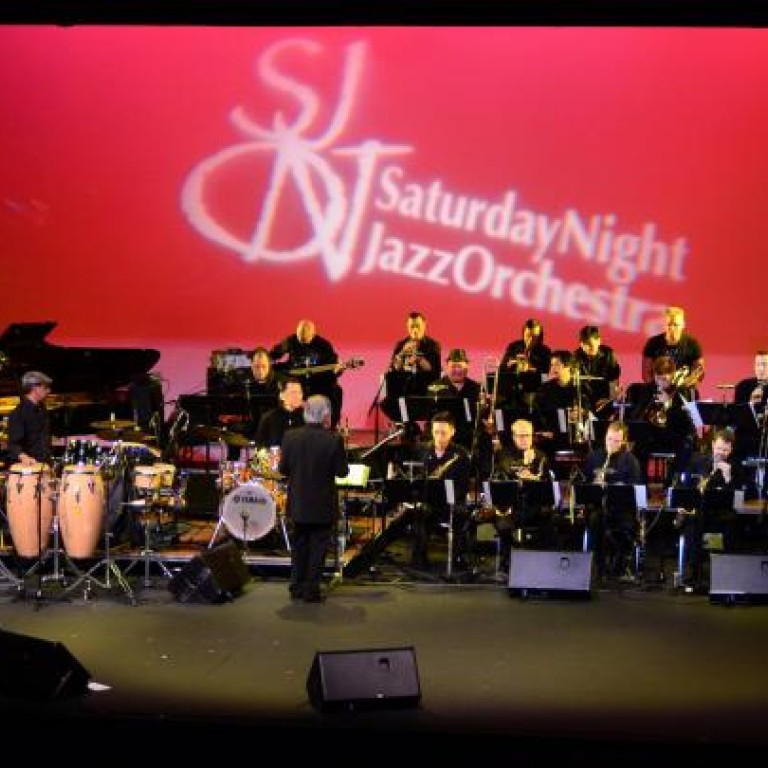
Arts reviews
About three quarters of the way through this celebration by the Saturday Night Jazz Orchestra of the percussive aspects of big band jazz, Drum Jam founder Kumi Masunaga sashayed on to the stage beating one of her collection of hand drums, and took over the show.
About three quarters of the way through this celebration by the Saturday Night Jazz Orchestra of the percussive aspects of big band jazz, Drum Jam founder Kumi Masunaga sashayed on to the stage beating one of her collection of hand drums, and took over the show.
Members of the audience were issued with a drumstick and one of several colour-coded plastic tubes, and given a quick lesson in what to do with them.
Within 10 minutes she had succeeded in getting 400 or so people to play a simple percussion melody, starting and stopping almost simultaneously, and in time, after which everybody was able to play along with the band on Duke Ellington's .
Masunaga is the living embodiment of infectious enthusiasm, and it was a night for enthusiasts. Regular orchestra singer Elaine Liu was delighted to be playing for the first time with the band on what she called her "new toy", a guitar with which she accompanied herself very capably for three bossa nova standards, while bandleader Taka Hirohama beamed with pleasure throughout the performance, and danced to the music as much as conducted it.
The band were on fine form, and swinging even harder than usual thanks to the impetus provided by star guest drummer Yoshinobu Inagaki.
Regular drummer Dulip "DC" Charith Wijesinha moved to percussion for much of the show, but also doubled on traps alongside Inagaki, and gave as good as he got in a spectacular drum duel.
There was an educational element to the evening, too. Ben Pelletier, who acted as master of ceremonies as well as playing trombone, conducted short interviews with Inagaki about the role of the drummer in jazz and with Tom Nunan on the subtle tonal differences between differently pitched saxophones.
Mostly, however, the evening was about swinging exuberance, as the band powered its way through classic arrangements by Med Flory's Supersax, Bill Holman and Neal Hefti, among others, including, of course, Wild Bill Davis' arrangement for Count Basie's , now the Saturday Night Jazz Orchestra's signature tune. It was a hugely enjoyable evening for both the SNJO and the audience.
The Magic of Mozart
Hong Kong Philharmonic
HK City Hall Concert Hall
Reviewed: Saturday by Sam Olluver
The Magic of Mozart Hong Kong Philharmonic HK City Hall Concert Hall Reviewed: Saturday Magic? There’s no doubting that Mozart has it in spades, but the spells don’t weave themselves.
Conductor Gerard Korsten and violin soloist Esther Yoo proved serviceable in their interpretative roles, but not as magical as their pedigrees might suggest: he is music director of the London Mozart Players and she was the youngest prizewinner at the International Sibelius Violin Competition in 2010, (she has yet to turn 20).
Before getting down to Symphony No 39 and the Violin Concerto No 3, Korsten had the challenge of selling us the overture and concluding ballet music from the opera Idomeneo.
Marc Rochester’s engaging programme notes reminded us that even Mozart (right) found himself rubbing against the grindstone occasionally: “That confounded ballet,” as the composer referred to the opera’s tail-piece, can easily sound like formulaic stodge, and it struggled to rise above that here.
Born in the United States, Yoo spent her formative years in Belgium and has notched up a string of appearances with distinguished orchestras and conductors. Her youthful inspiration was no doubt the reason why so many very young people were in the audience. She gave them some fine qualities to emulate in a poised and inventive performance that built on her warm sound and technical fluency.
The balance with the orchestra was off and so it came as a relief to hear Yoo on her own during the cadenzas.
Mozart’s last three symphonies were written with astonishing speed in an attempt to reverse his declining fortunes, and performances need to recreate the entertainment value that was crucial to achieving that goal.
Korsten gave us attractive hooks to latch on to here, particularly in the finale that ebbed and flowed with a persuasive dynamism.
The rustic spirit of the third movement’s vibrant dancing was well caught; the first movement’s imperious opening led to an account that was wellpaced and shaped. The slow movement, however, bypassed the filigree potential of its lighter scoring and feathery melodic sweeps, diminishing the contrast with the ensuing, muscle-bound material.

